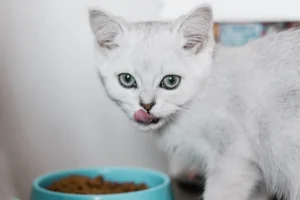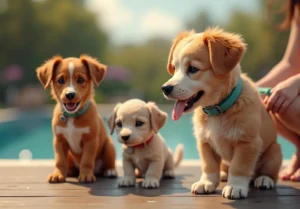Disclosure: We may earn a commission from helpful, relevant links in our content. No cost to you. See our privacy policy.
Diving into the world of feline diets can be a tricky endeavor, especially when your cat seems to have a penchant for wet food. Does this preference mean they’re missing out on vital nutrients?
In this blog post, we’ll explore the nuances of wet food, its nutritional adequacy, and how to manage your cat’s preference while maintaining their health.

Is Wet Food Nutritionally Adequate for Your Cat?
Wet food can indeed provide all the essential nutrients your cat needs for a healthy life.
High-quality wet cat food is formulated to be nutritionally balanced and complete, offering the right amounts of proteins, fats, vitamins, and minerals your feline requires. This goes for both adult cats and kittens.
If your cat’s energy seems to lag after switching to primarily wet food, it might be a sign they need a slight nutritional adjustment. Often, it’s just about tweaking portion sizes or frequency.
However, it’s crucial to select a reputable brand and follow feeding guidelines to ensure your cat receives the appropriate nutrients.
Wet vs. Dry Food: What’s the Difference?
Wet and dry food each offer unique benefits for your cat, and understanding their differences can help you make informed choices for your feline friend’s diet. Let’s take a look at the main distinctions between the two:
- Moisture Content. The most apparent difference is moisture. Wet food contains around 70-80% water, which can aid in hydration and support urinary tract health. Dry food, on the other hand, has a moisture content of around 10%, so it’s essential to ensure your cat has access to clean water when feeding them dry food.
- Texture. Wet food typically comes in cans, pouches, or trays, and has a soft, chewy texture that many cats find appealing. Dry food, or kibble, is crunchy and comes in various shapes and sizes.
- Shelf Life. Dry food has a longer shelf life and can be stored easily, making it a convenient option for pet owners. Wet food, once opened, has a shorter shelf life and must be refrigerated to maintain freshness.
- Nutrition. Both wet and dry food can provide a nutritionally balanced diet for your cat, as long as you choose high-quality options. Wet food often contains more protein and fewer carbohydrates, while dry food may have a higher carb content due to the manufacturing process.
Suggested read: Wet vs Dry Cat Food Guide
Health Implications of a Wet Food-Only Diet
While wet food can offer numerous benefits, such as increased hydration and lower carbohydrate content, a wet food-only diet may have some drawbacks.
Cats on a wet food-only diet might be at a higher risk of dental issues due to the lack of abrasive action provided by dry food. Additionally, wet food can be less cost-effective and less convenient to store compared to dry food.
Some cats on a wet-food only diet can experience softer stools. If you notice this consistently, try introducing a digestive supplement or probiotic after discussing with your vet.
To minimize these concerns, consider introducing some dry food into your cat’s diet or consult your veterinarian for dental care advice.
For example, a veterinarian may suggest regular teeth brushing and dental cleanings, as well as providing dental-friendly treats or toys to help maintain your cat’s oral health.
Balancing Your Cat’s Diet: Introducing Variety
To ensure your cat gets a well-rounded diet, it’s essential to introduce variety into their meals.
Mixing different types of wet food, flavors, and textures can help keep your cat interested in their food and provide them with a broader range of nutrients.
You could rotate different brands of wet food to ensure your cat is getting a diverse range of ingredients and nutrients. This can also help prevent your cat from developing picky eating habits. Each time you’re out shopping, pick up a different protein source like duck, rabbit, or venison. Novel proteins can provide essential amino acids that might be missing from more common ones like chicken.
Trats, such as Temptations, are yummy for cats, but they can’t be a sole source of food. Consider incorporating some dry food or offering treats in moderation, such as freeze-dried or dehydrated protein snacks.
Freeze-dried proteins are not just treats; they can be a valuable protein boost. If your cat’s wet food leans heavily on fillers, a sprinkling of freeze-dried chicken or fish can amp up the protein content.

How to Handle Your Cat’s Wet Food Preference
If your cat has a strong preference for wet food, it’s important to respect their natural inclinations while still ensuring they receive proper nutrition.
Offer high-quality wet food from reputable brands to guarantee a balanced diet, and establish a consistent feeding schedule to help regulate their intake.
You can also try gradually introducing dry food by mixing small amounts into their wet food, increasing the proportion over time.
Remember, patience is key when introducing new foods to your cat’s diet, and always consult your veterinarian for personalized advice based on your cat’s unique needs and preferences.
Related: How to Read Cat Food Ingredients List
Top Wet Food Options for Your Cat’s Needs
To help you make an informed decision, here are some of the best wet cat food options you can get that got great positive feedback from cat owners over the years:
- Wellness CORE Pate: A protein-rich, grain-free recipe featuring real meat, vegetables, and essential vitamins and minerals for balanced nutrition at all life stages.
- Nature’s Logic Feline Chicken Feast: A wholesome, grain-free option made with high-quality protein and real fruits and vegetables, free of synthetic vitamins or minerals.
- Stella & Chewy’s Chick Chick Chicken Dinner: Offering raw-inspired nutrition, this grain-free formula combines high-quality protein with fruits and vegetables for a natural, ancestral feline diet.
- Weruva Paw Lickin’ Chicken: Human-grade ingredients create a low-carb, grain-free wet cat food that offers a variety of protein sources to satisfy your cat’s natural dietary needs.
- Merrick Purrfect Bistro Chicken Pate: A grain-free wet cat food featuring real meat as the main ingredient, paired with fresh fruits and vegetables for well-rounded, balanced nutrition.
- Tiki Cat Grill Variety Pack: Gourmet wet cat food made with whole, shredded, or sliced meat or fish, offering low-carb, grain-free nutrition that caters to your feline’s natural dietary preferences.
Always monitor your cat’s weight and overall health, and consult your veterinarian for guidance on creating a balanced diet tailored to your cat’s specific needs.
Related: How to Choose the Right Wet Cat Food
FAQs
Can I mix wet and dry food for my cat?
Yes, mixing wet and dry food can help transition your cat to a more balanced diet, but introduce the mix gradually to avoid digestive issues.
Should I refrigerate leftover wet food?
Yes, leftover wet food should be refrigerated to keep it fresh and prevent bacterial growth. Leftover wet food should be used within 24 hours to maintain freshness and prevent spoilage.
Can I make my own wet cat food at home?
You can make your own wet cat food at home using recipes that include ingredients such as meat, vegetables, and grains. While homemade wet cat food is possible, consult your vet for recipes and guidelines to ensure your cat receives proper nutrition.
Suggested read: Homemade Cat Food Guide
How much wet food should I feed my cat daily?
In general, a healthy adult cat should eat approximately 3 to 5 ounces of wet food per day, split into two or three meals. However, the exact amount can vary depending on factors such as your cat’s age, weight, and activity level. Consult your vet for recommendations.
Alex, a passionate animal lover, has experience in training and understanding animal behavior. As a proud pet parent to two dogs and three cats, he founded AnimalReport.net to share insights from animal experts and expand his knowledge of the animal kingdom.




